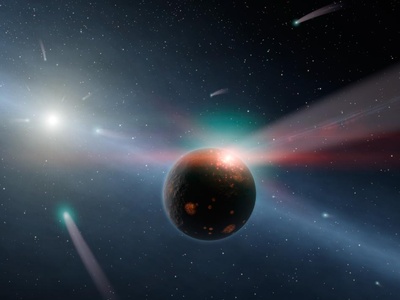Comet Storm in a Nearby Star System
"We believe we have direct evidence for an ongoing Late Heavy Bombardment in the nearby star system Eta Corvi, occurring about the same time as in our solar system," said Carey Lisse, senior research scientist at the Johns Hopkins University Applied Physics Laboratory in Laurel, Md., and lead author of a paper detailing the findings to appear in the Astrophysical Journal.
During the Late Heavy Bombardment, comets and other frosty objects from the outer solar system pummeled the inner planets. The barrage scarred our Moon and produced large amounts of dust.
Spitzer has spotted a band of dust around Eta Corvi that strongly matches the contents of an obliterated giant comet, probably destroyed by a collision with a planet or some other large body. The dust is located close enough to Eta Corvi that Earth-like worlds could exist in the collision zone, suggesting that planets like our own might be involved. The Eta Corvi system is approximately one billion years old, which researchers think is about the right age for such a hailstorm.
Astronomers used Spitzer's infrared detectors to analyze the light coming from the dust around Eta Corvi. Curiously, the light signature emitted by the dust around Eta Corvi resembles the Almahata Sitta meteorite, which fell to Earth in fragments across Sudan in 2008. The similarities between the meteorite and the object obliterated in Eta Corvi imply a common birthplace in their respective solar systems.
A second, more massive ring of colder dust located at the far edge of the Eta Corvi system seems like the proper environment for a reservoir of cometary bodies. This bright ring, discovered in 2005, matches the size of a similar region in our own solar system, known as the Kuiper Belt, where icy and rocky leftovers from planet formation linger. The comets of Eta Corvi and the Almahata Sitta meteorite may have each originated in the Kuiper Belts of their respective star systems.
About 4 billion years ago, not long after our solar system formed, scientists think the Kuiper Belt was disturbed by a migration of Jupiter and Saturn. This jarring shift in the solar system's gravitational balance scattered the icy bodies in the Kuiper Belt, flinging the vast majority into interstellar space and producing cold dust in the belt. Some Kuiper Belt objects, however, were set on inward paths that crossed the orbits of Earth and other rocky planets.
The resulting bombardment of comets lasted until 3.8 billion years ago. After comets hit the side of the Moon that faces Earth, magma seeped out of the lunar crust, eventually cooling into dark "seas." Everyone has seen them: Those seas form the distinctive face of the "Man in the Moon." Comets also struck Earth or incinerated in the atmosphere, and are thought to have deposited water and carbon on our planet. This period of impacts might have helped life form by delivering its crucial ingredients.
"We think the Eta Corvi system should be studied in detail to learn more about the rain of impacting comets and other objects that may have started life on our own planet," Lisse said.
For more information about Spitzer and Eta Corvi, visit http://spitzer.caltech.edu/ and http://www.nasa.gov/spitzer .
